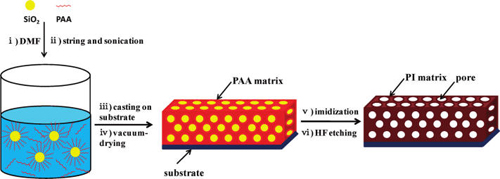
Schematic illustration for the fabrication of porous polyimide films with ordered surface using SiO2 microspheres as template.
Researchers at the R&D Center of Lubricating and Protecting Materials of the Lanzhou Institute of Chemical Physics (LICP), CAS, have developed a facile approach for the fabrication of porous polyimide films with an ordered surface.
In this approach, the polyamic acid (PAA, precursor of polyimide)/DMF solution was blended with silica microspheres first and then dried under vacuum to obtain PAA/silica composite film with well-ordered surface. After thermal imidization and removal of silica, porous polyimide film with 2D ordered surface was obtained.
This method needs no complex preparation process of template-like colloid crystals, as previously reported. It relies on the in situ self-assembly of PAA/silica complex microspheres where PAA chains interact with silica microspheres via hydrogen bonding during vacuum-drying. The study on the wettability behavior of the prepared porous polyimide films indicated that the ordered surface topography of the as-prepared polyimide films could change the wettability from hydrophilicity to hydrophobicity.
The approach is facile in that neither the preparation of special template nor complex preparation process nor precise control over condition is necessary. Furthermore, the method could be employed for mass production of ordered porous polyimide films, and by changing the content and size of silica microspheres, the pore size and porous structure of the porous polyimide films could be tunable. This technique presents a simple paradigm in the preparation of porous polyimide films with an ordered surface and may be extended to prepare other ordered porous polymer films.
The work has received support from the National Science Foundation for Distinguished Young Scholars of China, Innovative Group Foundation of National Science Foundation of China and National Program on Key Basic Research Project of China.
It findings have been published in Langmuir (Langmuir 2010, 26(23), 18357–18361).
Further references:
Page of Prof. WANG Qihua (corresponding author of the paper)


